LT Rob Harris, Concord Doc in the early 70’s contacted our association and said he had some memories to share. He had read in our “sea-stories page” a mention of an officer who willingly stood mail buoy watch to ensure the quality of our shipmates lives by grabbing their letters from wives, kids, girlfriends etc and safely bringing them to the security of his shipmates hands. He even provided photographic proof of his dedication to duty and willingly wished to share his endvour with all of us. I really appreciated his willingness to contribute to our site and asked him to send in as much as he wished and I would share it with all hands. Below you will find his (as he calls them vignettes), and I will update this page as he submits his thoughts. Thanks Doc on behalf of the crew. Good Stuff!
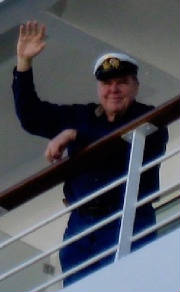

Vignette #1 Reporting aboard (1971 – 1972) Reporting aboard in August 1971 relieving Barry Shultz, who I came toappreciate was a superb physician and planning his post Navy careertraining as a urologist. The Concord had sailed for Glasgow the day beforeand we both anticipated we could do a turnover in Glasgow. The Navy saidno. We could wait for the return to NOB in 3 weeks. I was assigned to theVulcan, a WWII repair ship in the interval. My family had not yet arrived, so Ilived aboard Vulcan in the MO’s SR. He had been a couple of years ahead ofme in Med School and we knew each other, making the transition from internat Oakland Naval Hospital to operational duty smoother.During my free time, I walked the piers, trying to learn everything I couldabout ships, the sea, and the Navy. I had always loved ships and the sea,having lived in South America growing up. In those days we traveled by ship,not airplanes.I especially enjoyed harbor Ops. They took me on their wing when I had thetime, teaching me about the various ships, ship handling, and tug operations.When CONCORD returned, they took me out to meet her with the ThimbleShoal pilots aboard a Navy YTB (tug). Climbing up a Jacob’s ladder to theweather deck, I landed on the Concord for the first time. Everyone wassurprised the new doc reported aboard by sea and thought I must be reallygung ho! On the signal bridge, as we entered Norfolk harbor, I wasintroduced to CAPT Stilwell CO, CDR Dewey XO, and LT Barry Shultz for thefirst time.Thus began one of the happiest, exciting, instructional years of my life. I grewto admire and respect the CONCORD crew and officers, who patiently showedme the ropes of a Navy ship at sea. I determined to learn just abouteverything about you, your jobs, your concerns that I could. It set the stagefor a subsequent 23-year career in the Navy.H Division consisted of HMC Ed Lloyd of Baltimore (a master of NavyBureaucracy and paperwork), HM2 Ron Dods (a Viet Nam veteran andformer policeman in St. Louis, with an amazing sense of recognizing seriousillnesses), HM3 Larry Callison (a thoughtful, perceptive well -read Corpsmanfrom TX, and HM3 Chuck Kyle (a remarkable X-ray Tech at Oakland NavalHospital when I was an intern. He had to do sea duty next, so he came withme from Oak Knoll). We transiently had a striker or two, whose names Iregrettably can’t remember. Together, despite limited capabilities of ashipboard medical operation, we practiced some of the best medicine of mycareer (which included training at the Mayo Clinic and the University ofMinnesota). It was a remarkable group, and those of you aboard in thosedays, were fortunate to have them care for you.Barry was an amazing physician . . . mellow, knowledgeable, capable. Afterorientation to the medical facilities and H Division Staff, we checked supplies,inspected the medical spaces, and reviewed the medical logs beginning in1968, when the ship was commissioned. There had been only one tragictraumatic death a couple of years previously, reported in this websitepreviously. A sailor became trapped in a chain attached to a huge hatchcover, which subsequently came down and killed him as we understood it.The most common severe illness was coronary artery disease with heartattacks. No big surgery had ever been performed, as patients who required itwere often aerovaced ashore or to carriers with complete surgicalcapabilities. Turnover complete, we began preparations for our upcoming 6month Med Deployment.I have prepared some of the most memorable events and people of mydeployment here for your interest and amusement. Almost 50 years haveelapsed since that year, so some recollections may be flawed or distorted bythe prism of my memory. Nevertheless, the memories remain vivid to me,and hopefully these will trigger your own memories. Please feel free tocorrect or edit as appropriate!
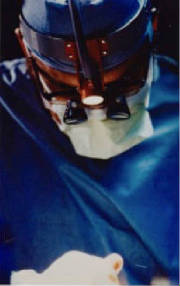

Vignette #2 Doc vs DoctorDoc vs. DoctorAround the second day after returning from Glasgow, Barry took me up toformally meet CAPT Stilwell. Barry gave us a brief introduction and departedto help with his family at home for the remainder of the day.I thought the Captain was impressive as we discussed my new assignmentaboard CONCORD. It was mostly about me . . . who were my parents? Did I getmarried and medical school and how old was our daughter? Where did I goto College and Medical School? Where did I intern and how was the callschedule? Did I learn a lot? What were my hobbies and interests? What kindof medical training was I pursuing after the year at sea? Had I consideredpursuing medical education in the Navy? If not, how did I plan to spend the 3years of payback obligation in the Navy? Could he do anything to make mytime in the Navy worthwhile? He encouraged me to take advantage of allopportunities this year with him at sea would offer, and he’d help me do thatif he could.Then he briefly reviewed his 40 year career in the Navy, beginning withgraduation from King’s Point, and then going to sea aboard destroyers. Hegrew to love the Navy and remained a WestPac sailor the bulk of his career.He pointed out the cornea of his right eye which was cloudy and opacifiedand asked me what I thought that was. I said I couldn’t be sure but likely to
be traumatic or infectious. He smiled and said it was traumatic and he’d tellme the story one day. He had the distinction of being the only one-eyedCaptain in the Navy.Then I got “The Lecture”. “Doc,“ he said, “until you and Barry Schultz, I’dnever had a medical officer on any of my ships.” He had to rely on hisCorpsmen and self-education to handle medical conditions and emergencies.This had served him and his men well for 40 years and he couldn’tunderstand why this ship had a requirement for a medical officer as he coulddo as he always did.That being said, he thought he was glad to have me aboard and lookedforward to a fruitful year at sea for the two of us and the ship’s company. Hisdoor was always open. He concluded reviewing a little history. He said theterm “Doc” was reserved for all aboard for the medical leader, be he enlistedor officer. It was a term of affection and respect. He’d heard from hiscolleagues that many medical officers did not like the term Doc, preferringthe more formal Doctor.“Well, Doc, on this ship while I am in command, Doc means you’re doing yourjob right, which is what I expect. If the crew is calling you “Doctor,” thatmeans you are losing their respect and affection. And if I call you, “Doctor,”that means it’s something very serious or your ass is in trouble! Is thatunderstood? Unless you have anything further at this time, you are dismissedto go back to learning about CONCORD, her crew, our jobs, and whateveryone expects of us. Nice to meet you!’ And that was that!

Vignette #3 Mail Buoy Watch
Trans- Atlantic Mail Buoy Watch We had only been a few days out of Norfolk, when one early afternoon the word was passed to all hands to station the “Special Mail Buoy Watch.”Having no idea what that even was, I proceeded to the Bridge to make an inquiry. There, I saw the CO, XO, Officers of the Watch, and others on the port wing of the bridge looking down on an amazing site. Here was this sailor standing there, gaff pole and canvas bag in hand in a life jacket and a helmet on. “What was going on?” I asked. The XO explained that there had been a special mail pouch drop at sea with mail destined for CONCORD in it, and now we must retrieve it. I thought that was a bit strange not hearing anything about approaching aircraft or anything else. He pointed to the SA standing at attention while others scanned the horizon for the mail bag. So . . . what happens when you see it, I asked. Why the SA will lean over and attempt to retrieve it with the gaffe. But we are 50 feet above the water and the pole is only 10 feet long. In that case, the Captain and XO responded in all seriousness, we might have to launch the helos or a motor whale boat to retrieve it. The first order of business was to find it, floating on the water far out in the Atlantic. They gave me a pair of binoculars and told me to help out in the search. I bit, and started looking for a mail pouch. Then I started thinking . . . . this is crazy and I scanned the decks and saw everybody laughing and suspected something was up. Finally, after pestering them, they came clean and told me the truth. Meanwhile the Mail Buoy Watch stander had been relieved several times by other SA’s. They were starting to get suspicious, volunteers were dwindling to assume the watch. So the XO suggested that I go up there and assume the watch as well to show that even first-time officers had to stand the watch. I felt bad these SA’s might be annoyed at the prank, so I agreed to share in the fun (and the pain). While standing there the Bos’n peppered me with questions about the location of the relative bearing grease, and several other items of interest. I thought there actually might be some of these items, but found it strange. When the affair was over, everyone had a good laugh, I had participated in one of the traditional “hazing” adventures of a newbie.
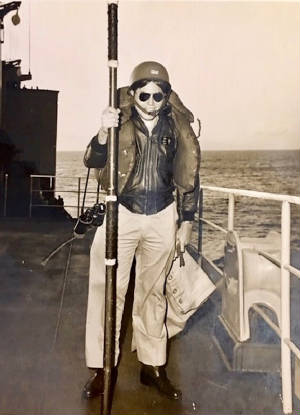
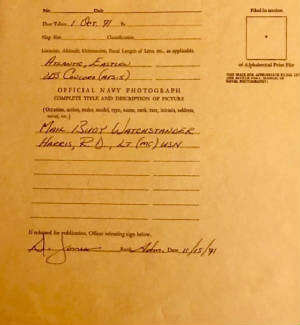

Vignette # 4 (honory enlisted Doc) The H Division wanted me to chow down with them one evening. On account of me being an officer, they decided to “smuggle” me in as enlisted-man to keep the Chiefs off our backs!
They created a special rank, HM1 S (as in super!, since we had no first class Corpsmen aboard). Our LPO, Ron Dods got me a special Chambray shirt with a custom designed insignia, befitting my new rank and someone lent me their dungarees for the evening. And off we went. No one was put on report nor went to the brig! A good time was had by all! And …. my disguise fooled all the Ciefs
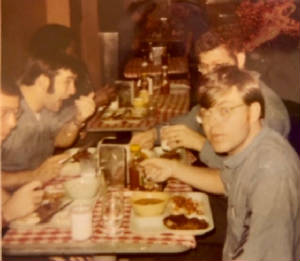

Vignette # 5 The Blue Flame of H-DivisionWhen Barry was orienting me to the Department and my newresponsibilities, he opened the large closet of medical supplies and there . . .he proudly showed me, were boxes of good European Wine he collected onthe cruise to take home. In addition he had a full pallet down in one of theholds. I’d never seen so much vino. He was a serious student of fine wine andcould never find these at an affordable price back in the States. He joked, “IfCONCORD ever gets torpedoed and explodes, H Division would burn with agiant blue flame, like a big crepe suzette.”As we all know, our beloved ship was torpedoed and exploded . . . but therewas no blue flame. I took comfort that none of his fine collection was leftbehind. And the image that persists to this day is of all our fellow CONCORDveterans up in heaven sitting around, sipping Barry’s fine wine, toasting the memory of our great ship.
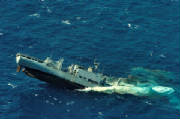

Vignette # 6 Movie CallTwo Movie Calls for the 16mm movies shown nightly at sea are memorable.The first was for Henry the Eighth and the second was Road to Salina.
The call by the BM reading the exact label on the cover of the movie went out:“Now the movie in the Crew’s Mess this evening will be “Henry the VIII, byShakespeare, starring Richard Burton.” We figured it must be an Aviation BMon the mic, as he read it: “Henry the VEEE One Eleven!” Took us a while tograsp that . . . and thank you HC6 for the memory!The second was Road to Salina, starring Mimsy Farmer. She was an actresswhose first role was at age 11 in Spencer’s Mountain. By the time she madethis one she had transited puberty and was a beautiful grown woman. I don’tremember the plot (if there was one). It was one of the early soft core pornmovies trying to go mainstream and was remarkable for one scene of Mimsyin full frontal nudity. It had three reels, but all the action was in reel 2.The call always went out for this movie (shown repeatedly on our MedCruise): “Now the movie in the wardroom this evening will be the second reelof Road to Salina!”CONCORD was the movie ship for the 6 th Fleet in those days, distributing allthe flicks to others. The second reel of Road to Salina NEVER left the ship!Too bad, you other ships!Enter supporting content here

Vignette # 7 Filler Up Several times the ships of SERVRON FOUR tried to jazz up unrepping.CONCORD had a big flag we flew on occasion. It had the logo of SuperGiant, the big grocery store.But the best of all was one of the AOE’s(can’t remember which one, maybe DETROIT). As we came alongsidethey were blasting the Tia Juana Brass’s “The Lonely Bull” on their1MC. “Good morning on CONCORD from DETROIT, the fastest, best-lookingfilling station and ship in the Navy! Stand by to receive shot lines!” Thehoses were attached and refueling began.Then they announced they were sending a helo over with importantmaterial for the Captain. The helo landed and this dude in whitecoveralls and a funny looking hat proceeds to the bridge on theweather deck in full view of everyone. He was carrying a big whiteplastic bucket with a stick pointing up.
As he ascended the ladder to the starboard wing of the bridge, a bigflag unfurled from their mast to the tune of the now defunct oilcompany’s jingle on TV at the time. It was a huge Texaco flag and thejingle was “You can trust your car to the man who wears the star, thebig bright Texaco star.”He reported to the Captain in his white coveralls with a big Texacobadge on the left and “Jimmy “ or some name embroidered on theright. He was carrying window cleaner and a squeegee and rags. Herequested, and was granted, permission to clean the bridge windows.He did and took out a little whiskbroom to sweep around the helmstation.After insuring we were happy with the service, he requestedpermission to return to the gas station and took off back to DETROIT.When refueling was completed, we broke away to the coda of Flattand Scruggs Dueling Banjos as they hauled the big Texaco flag down.And, as they turned to starboard, the music volume decreased and asouthern drawl voice yells out, “Y’all come back now . . . YAHEAAAHH!?”
Click Here To relive the Texaco Jingle

Vignette # 8 You have to learn to talk NavyThe Captain was a stickler for proper shipboard terms while sailing on hisships. I wasn’t when I first got there. After one early evening in his big PortCabin, I finished whatever the business was and asked if it was ok to godownstairs to my bedroom . . . .“What did you say????,” he asked with dismay. DOCTOR . . . you must learn totalk Navy. There are no stairs on a ship, only ladders. You do not go “down”(unless it’s with your ship), you go down below. You never go up, you gotopside, left is port, right is starboard, and your “bedroom” is a stateroom.You never go to the front, you go forward, and back is aft. You really have tolearn how to talk!
“Capice????” If not, I may have to get the Bos’n to come here and stuff yourthrough that little round window over there,” pointing to a porthole to hisleft. Never forgot that!

Vignette #9 Malaga first visit…..Doctor haven’t you heard The song……I always enjoyed coming into and leaving a port on the bridge, observingshiphandling, listening to the commands, learning to read the water,watching the wind, etc. And my nautical vocabulary improved.Very few people aboard were fluent in Spanish in those days. Once theCaptain realized I spoke the language, he wanted me to be on the bridge totranslate what was going on with the informal conversations between thepilot and the tugs. Pretty soon I was relaying the orders from the Spanishpilots. Really cool. A real sense of power as I passed on the commands andobserved what happen with this big ship.He wanted to know what all the chatter was on the pilot and tug walkie talkiewas. The pilot was animatedly shouting into his hand held to the tug skipper,“mira, Francisco, cuando llegamos al muelle vamos a pasar por la bodega ytomar una cervecita!” The conversation was animated.‘What’s he saying,? our Captain asked.Not much . . . He’s just asking to go out for a beer with the tug skipper, whenwe get all tied up at the dock. A sigh of relief!In Malaga harbor, we would drop the forward starboard anchor until itgrabbed and then pay out the chain as the tugs maneuvered us to the dock.Then when we left, we only needed one tug as the forward anchor chain waspulled and the bow of CONCORD moved towards the anchor. Saved money!I was coming to learn the chants accompanying this maneuver, which areused the world over since folks first put to sea, I suppose. The Spanish tugwould cry out, “Queda la cadena arriba y abajo con mucha fuerza” the chain isup and down with lots of strain. “Ahora, queda el ancla libre, the anchor isfree!”I turned to the Captain and told him they were saying the anchor was free,you know what I mean Captain? It’s not stuck in the mud anymore. Sir, isn’tthere a term in the Navy when the anchor isn’t stuck anymore?
“Doctor, it’s Anchors Aweigh, it’s Anchors Aweigh!” throwing up his hands indismay (or disgust, not sure which). “Haven’t you heard the song, haven’t youheard the song????

Vignette # 10 Formal INCHOP RotaAfter several trans-Med runs, all the ships leaving and those relieving,gathered Bay of Cadiz. I went up to the Bridge and looked all around. I hadnever seen so many ships in one place. It was at the height of the cold war. Itwas disturbing.I asked, “Have we learned nothing since Pearl Harbor?” All our assets in oneplace . . . one well-placed missile could take all the ships out, both incomingand outgoing. Never got an answer.Here, I finished another goal when I went aboard SAN DIEGO (AFS-7) to visittheir Medical Officer and look around. With this visit, I had now been aboardall seven AFS’s, both West Pac and Atlantic. I have no idea why that was soimportant to me. The conclusion: CONCORD was the best!

Vignette # 11 Tiny’s ToothacheTiny (Musselman, if I recall his last name correctly) was the biggest beardedBos’ns mate I’d ever seen. He was hard-working and had no patience fornonsense. He worked all over the ship, seemingly all the time, nevercomplaining.He presented to Sick Call one afternoon with a monstrous toothache. TheCorpsmen screened him, and because his jaw was so swollen and he was inmisery, they wanted me to check him out. It was a big abscessed tooth. Wewere due to rendezvous with a carrier the next day, with full dentalcapability. So I elected to treat him with pain pills and antibiotics until themorning. He was not happy. He wanted his tooth out right now.I explained I had no dental training, and arranged for a flight over to thecarrier the first thing in the a.m. He was upset. I told him to return later ifthings got worse.
Tiny came back to sick bay as described. He asked Dodd’s to yank his tooth and Dodd declined. Tiny then said, “Well if you won’t do it, and Doc won’t do it, I’ll just have to do it myself. Then he leaned over, and with a big huge big filthy Bos’ns pliers, reached in his mouth and extracted his own tooth!”About an hour later, Ron Dods called me down to see something. There onDods’ desk was a tooth! He couldn’t believe what just happened. Tiny cameback to Sick Bay after I left and wanted a Corpsman to pull his tooth. Theydeclined, and he then leaned over the desk, reached in his leather tool pouch,grabbed a big pair of pliers and . . . . pulled his own tooth! So we gave a gauzebite block to use until the bleeding stopped, iced his jaw, and sent him over tothe carrier the next morning. The carrier dentists cleaned it up andcomplimented him on his dental skills and sent him back!23 years later, I was making rounds with the neurosurgery residents atBethesda, and lo . . . who had been admitted for a lumbar laminectomy forherniated disc????!!!! Tiny!!! He was now a BMC, big kahuna with a job at theNavy annex, sans beard, still huge. We reminisced about that incident. Theneurosurgery residents couldn’t believe it. His back surgery went fine and hewent back to full duty.

Vignette # 12 Appendicitis at seaWe had been steaming independently for several days and not due torendezvous with another ship for several more. We were miles fromanywhere. It was in the wee hours of the morning when the Corpsmen calledme down to sickbay to evaluate a sailor with acute severe right lowerquadrant pain. I checked him out and agreed it was probably appendicitis.We did a white blood cell count which was only mildly elevated.I thought it best to alert the Captain. He had already warned me at thebeginning of the cruise, only he makes the decision where to go in the eventof a medical emergency. My job was solely to inform him of the issue and hewould take it from there.Climbing up the ladder to the bridge deck, I knocked on his sea cabin doorbehind the bridge and entered. He had been sound asleep and groggilychecked his watch as he awoke. “What’s happening?” he asked.Sir, I believe we have a case of appendicitis in sickbay. Really? How do youknow that? The dialogue that followed made me think I was talking to myChief Resident in surgery, not a line Captain.“What does he have?” he asked. “Probably appendicitis, “ I replied. “No Doc,you already told me that. What are his signs and symptoms? I want to knowwhat symptoms he has and how you arrived at your conclusion.”“Well he has right lower quadrant pain,” I replied. “Is that all, Doc? You meanto tell me you woke me up at 0200 to tell me you have someone in sickbaywith RLQ pain? I mean give me a break! If you wake me up at 0200 again, youbetter come equipped with better information than that.”I was starting to get nervous. Well, Sir, he has the symptoms of earlyappendicitis. “Is there tenderness in the RLQ,” he queried, rubbing his tiredeyes. “ Yes Sir.” Does he have rebound? A little, I said.
Rebound tenderness is a very sensitive sign in his experience, he mentioned. Does he have a fever?No. Does he have bowel sounds? Yes. What’s his white count? 9600. Is hehungry? No sir. What’s his urinalysis show? I didn’t get one. How about hisrectal exam? Did that confirm the tenderness on his abdominal wall? I didn’tdo a rectal.He sat bolt upright in his bunk and yelled, “Doc, so you wake me up at two toreport a case of belly pain with minimal laboratory support and an
incomplete physical examination. Surely you can do better than that! Isuggest you go back down to sickbay, complete your workup and read up ondiagnosing appendicitis. Then call me. Is that clear? Yes Sir.I scurried down below to determine how to proceed next, finished my exam,and started reading my Surgery textbooks again. Not 15 minutes after I lefthim, the phone rang. “Doc, this is the Captain.” I know, I recognize your voice.“Doc did I yank your chain?”You sure did. “Well, I just wanted you to know I know a little bit aboutappendicitis from all those years being alone without a medical officer. I reada lot and learned a lot from the corpsmen. But, if you say he has appendicitis,that’s good enough for me. I’ve instructed the bridge to determine thenearest carrier or shore facility nearby and hopefully have him off the ship in18 hours where he’ll get an appy if they concur with your diagnosis. And inthe morning I’m going to bring you a little book to read.”That morning he showed up in sickbay with a well-worn copy of a medicalclassic, “The Early Diagnosis of the Acute Abdomen” by Sir Zackary Cope, anearly English surgeon, with more pearls of wisdom than have ever beenpublished since. “I found this book in an old bookstore somewhere and I’vebeen reading it when necessary for my 40 year career. You might find ituseful and you’re welcome to borrow it if you want. Anyway, just wanted youto know I know a little bit about acute abdomens!”

Vignette # 13 Trans-Atlantic with Adams’ Physical DiagnosisThere was a famous textbook (and Bible for Medical Students) called AdamsPhysical Diagnosis, An Introduction to Clinical Medicine, which presentedperformance of a physical examination in great, understandable detail. Ibrought my copy aboard for our Med Cruise and divided up the chapters foreach Corpsman. They reviewed their assigned chapter and presented asummary to the H Division every day of our Trans-Atlantic crossing. Wediscussed the chapter and demonstrate the techniques discussed.They learned to inspect, palpate, percuss, and auscultate (Look, Feel, Tap,and Listen). They learned how to take a good history from a patient,remembering . . . the patient is always telling you the diagnosis. They werequick studies and I was impressed with the remarkable skills developed inthe span of a couple of weeks.They then ran sick call unsupervised in the morning, with a joint review foreach patient when they had completed their assessment. The rules were thatthey could admit anyone to sickbay, but I had to review anyone theydischarged from sick call. This insured independence and supervision.As later vignettes will reveal, their skills saved a couple of lives, and also made sure the ship’s company received remarkable medical care for our deployment. It was an honor to work with them.

During the 1971-1972 Med Deployment I learned ship handling under the tutelage of the Captain, XO, Watch Officers, and Quartermasters. Finally, our skipper let me conn the ship and I brought her alongside our sister ship, USS Sylvania (AFS-2). My medical school and intern classmate was the MO aboard Sylvania. As we made the approach, CAPT Stilwell had the signal bridge run up the flags announcing “My Doctor Has the Conn”. The Sylvania went to General Quarters and their skipper dragged my classmate out of bed to the wing of the bridge so he could witness what a “real ship’s surgeon” could do.
Bernie, my medical school and intern classmate, never forgave me!

Vignette # 15 Barcelona “Time in a Bottle”, Jim Croce
But there never seems to be enough time
To do the things you want to do once you find them
Messages in a bottle have been a fixture in writing for eons, as nicely reviewed by Clint Buffington in Stories, Facts, Myths, and News -https://messageinabottlehunter.com/
Concord would add its own chapter!
Barcelona was our first true liberty port in 1971 after our trans-Atlantic crossing and a couple trips across the Med unrepping 6th Fleet warships. 20 + days at sea w/o stopping, working 20 hour days as we unrepped, seemingly night and day.
The crew was exhausted and ready to party at a favorite liberty port. In the misty grey of early November’s first light, passing the long old seawall of the Port, under Montserrat, we finally pulled into our slip in downtown Barcelona .
Everyone was anxious to touch terra firma and celebrate. However, on the pier were on these 2 guys in black trench coats with matching fedoras pulled way down over their foreheads carrying black brief cases. They looked exactly like these 2 guys below right from Mad Magazine’s old days.
They ascended the gangway to the quarterdeck and told the OOD no one was to leave the ship asking to be taken directly to the Captain. The word was passed on the 1MC announcing Liberty was cancelled. Everyone was getting nervous.
For 2 hours everyone milled around wondering what was going on. The two gentlemen in trench coats finally departed the ship. Then, the Captain announced there would be an AOM (all officers’ meeting) in the Wardroom.
He came down steaming mad clutches a sheet of paper and took his seat.
He explained that apparently a bottle had washed ashore in Sicily and was found on the beach by some Italian fishermen. They didn’t know English so they took the bottle and note to the local carabinieri who became alarmed they had delivered to Naples who referred on to Rome.
In Rome, they also were alarmed and had the bottle and its contents flown to Paris to INTERPOL for analysis. After researching the note they determined their inspectors would have to visit Concord in person to determine exactly what happened.
It turned out the 2 guys in black were INTERPOL agents sent down to the USS CONCORD to further investigate the origins of the note and verify that no prisoners were aboard Concord.
He read the note aloud to us:
“HELP HELP! I AM BEING HELD PRISONER ABOARD USS CONCORD (AFS-5) FPO NY 09501! NOTIFY POLICE AND AUTHORITIES! SEND HELP RIGHT AWAY!
P.S. F—— SK2 JEREMY JONES (not his real name) AND HIS GEDUNK!”
Then, in a scene right of Mr. Roberts, the Captain looked up at the rest of us shouting, This will be the LAST message in a bottle thrown overboard from this ship as long I am commanding.
He ordered us to our Divisions, share the contents of the bottle with our people and to warn them if it ever happened again, all liberty would be cancelled for the rest of the 6 month deployment. I went back below to Sick Bay to follow my orders. Patients and Corpsmen all gathered round to find out what was going on.
When I told the story, one of them started jumping up and down yelling and screaming YAY! I’ve been throwing bottles with notes my whole 8 years in the Navy in both the Atlantic and the Pacific. This is the first time one of them landed! I asked the culprit, “Why are you being so nasty to Jones in your note. I thought he was a pretty good guy.”
“Jones pissed me off. He keeps charging me (like a very nominal fee of 10 cents) for my frozen vanilla custard instead of giving it to me free, like I always give him free meclizine when he’s seasick.”
I pointed out the gedunk is a Navy concession like the BX which requires a payment. Its proceeds go to MW&R fund for the benefit of the crew. The Medical Department, on the other hand is required to provide all our services (this WAS 1971 after all!) for free. The culprit said, that doesn’t matter “I still can’t stand Jones!”
No more messages in bottles were thrown over the side for the remainder of the cruise.

Vignette # 16 The First Drug Screening
We were the first ship selected for a mass drug screen to test the system to be used in the Atlantic and 6th Fleets. It was madness. The Ship’s Doctor had to personally witness all the officers and crew whiz into a jar, seal them with the proper ID, put them in special mail pouches, etc etc and send back to Norfolk. I couldn’t believe we were actually having to do this. We got some sort of citation for the organizational skills and effort to comply. HMC Ed Lloyd (pictured below) executed their orders.
As a reward for this, CAPT Stilwell and CDR Dewey had a mahogany plaque prepared for presentation to HMC Lloyd and H Division at one of the Inspections. Affixed was a plastic urine jar (never used) and a plaque reading:
“To H Division for Outstanding Performance Under Piss Poor Conditions.”

